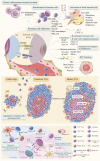In-depth insight into tumor-infiltrating stromal cells linked to tertiary lymphoid structures and their prospective function in cancer immunotherapy
- PMID: 40784879
- PMCID: PMC12337498
- DOI: 10.1186/s40164-025-00695-8
In-depth insight into tumor-infiltrating stromal cells linked to tertiary lymphoid structures and their prospective function in cancer immunotherapy
Abstract
Background and purpose: The tumor microenvironment (TME) is widely acknowledged as a pivotal regulator of cancer progression. However, the dualistic role of tertiary lymphoid structures (TLSs), which serve as critical immune hubs within the TME, remains incompletely characterized, particularly with respect to their context-dependent capacity to either inhibit or facilitate tumor development. This review aims to synthesize current understanding of the complex interactions between stromal cells and TLSs, addressing existing gaps in mechanistic insight and exploring therapeutic avenues to exploit TLS plasticity.
Key reviewed topics: The current study critically reviews the mechanisms by which stromal components, including cancer-associated fibroblasts and endothelial cells, contribute to TLS neogenesis through chemokine-mediated recruitment of lymphocytes. Furthermore, it highlights the dual functional roles of TLSs as sites of both anti-tumor immune activation and immunosuppression, notably via the enrichment of regulatory T cells. The clinical implications of mature TLS presence, particularly their association with improved patient prognosis and enhanced therapeutic responsiveness, are also analyzed.
Main conclusions: TLSs demonstrate a bifunctional nature, wherein their spatial organization and dynamic interactions with stromal elements dictate the balance between immune activation and tolerance within the TME. While mature TLSs are generally correlated with favorable clinical outcomes, their potential to foster immunosuppressive microenvironments necessitates the development of precision-targeted interventions. The interplay between stromal cells and TLSs represents a promising therapeutic axis for modulating the tumor immune milieu.
Future perspectives: Future research should prioritize strategies aimed at promoting TLS maturation, disrupting immunosuppressive niches, and integrating TLS-modulating agents with existing immunotherapeutic regimens to enhance clinical efficacy. Additionally, the identification of robust biomarkers reflective of TLS functional states and the rigorous validation of stromal-targeted therapies within combinatorial treatment frameworks are imperative for advancing translational applications.
Keywords: Cancer immunotherapy; Neoplasms; Stromal cell immunomodulation; Tertiary lymphoid structures; Tumor infiltration; Tumor microenvironment.
© 2025. The Author(s).
Conflict of interest statement
Declarations. Ethics approval and consent to participate: Not applicable. Consent for publication: All authors have read the final version of the manuscript and declared their consent for publication. Competing interests: The authors declare no competing interests.
Figures





Similar articles
-
Interplay between tumor mutation burden and the tumor microenvironment predicts the prognosis of pan-cancer anti-PD-1/PD-L1 therapy.Front Immunol. 2025 Jul 24;16:1557461. doi: 10.3389/fimmu.2025.1557461. eCollection 2025. Front Immunol. 2025. PMID: 40777041 Free PMC article.
-
Interferon Regulatory Factor 4 Recruits Immature B Cells to Signal Tertiary Lymphoid Structure Immaturity and Progression of Clear Cell Renal Cell Carcinoma.Int J Biol Sci. 2025 Jun 9;21(9):3827-3851. doi: 10.7150/ijbs.113737. eCollection 2025. Int J Biol Sci. 2025. PMID: 40607252 Free PMC article.
-
Density of tertiary lymphoid structures predict clinical outcome in hepatoblastoma.Pediatr Res. 2025 Jul 9. doi: 10.1038/s41390-025-04210-x. Online ahead of print. Pediatr Res. 2025. PMID: 40634689
-
Insights into tertiary lymphoid structures in the solid tumor microenvironment: anti-tumor mechanism, functional regulation, and immunotherapeutic strategies.Cancer Biol Med. 2021 Sep 24;18(4):981-91. doi: 10.20892/j.issn.2095-3941.2021.0029. Cancer Biol Med. 2021. PMID: 34553849 Free PMC article. Review.
-
A novel immunological perspective on female-specific cancers: Exploring the signaling pathways of tertiary lymphoid structures and their clinical applications.Life Sci. 2025 Sep 15;377:123800. doi: 10.1016/j.lfs.2025.123800. Epub 2025 Jun 4. Life Sci. 2025. PMID: 40480623 Review.
References
Publication types
LinkOut - more resources
Full Text Sources

